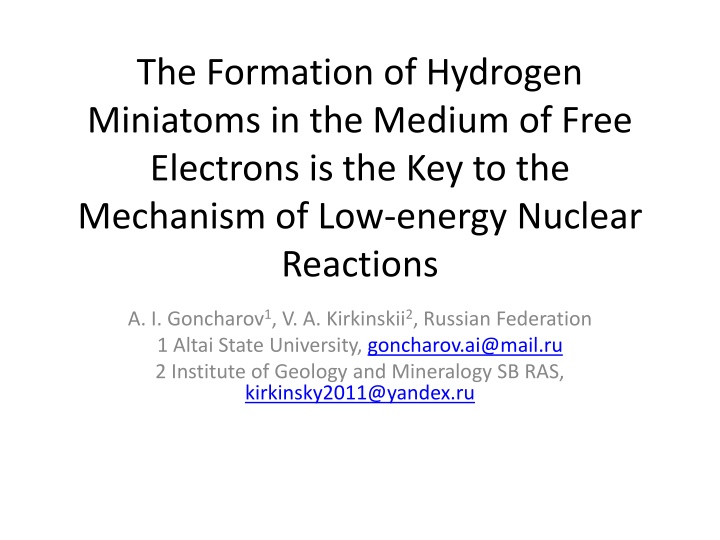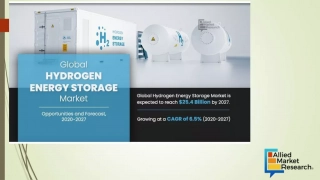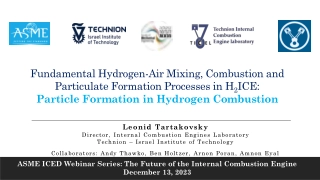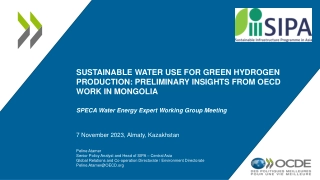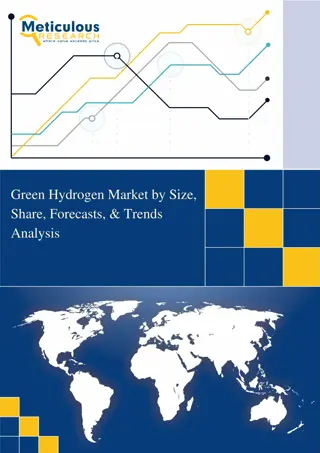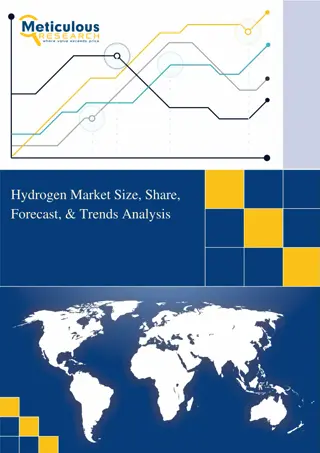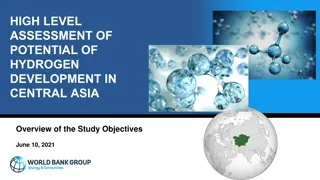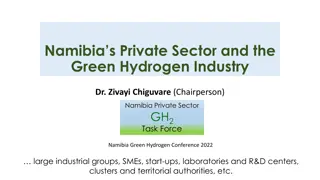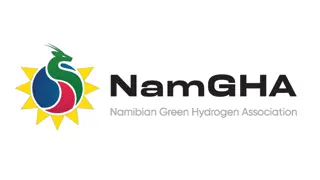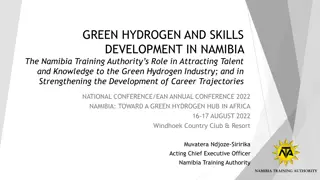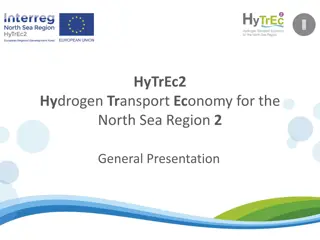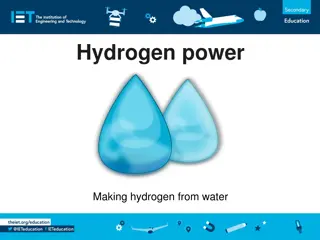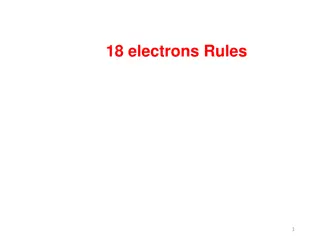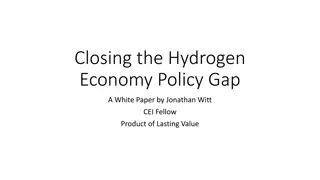Formation of Hydrogen Miniatoms in Free Electron Medium
Using computer simulations and molecular dynamics methods, the study explores how free electrons in metals affect hydrogen isotopes, potentially accelerating nuclear fusion reactions. The research models hydrogen atom behavior in the flow of free electrons, providing insights into low-energy nuclear reactions and the distribution of "miniatoms". Detailed tables and figures illustrate collision events and size distributions, shedding light on the mechanism behind this phenomenon.
Download Presentation

Please find below an Image/Link to download the presentation.
The content on the website is provided AS IS for your information and personal use only. It may not be sold, licensed, or shared on other websites without obtaining consent from the author.If you encounter any issues during the download, it is possible that the publisher has removed the file from their server.
You are allowed to download the files provided on this website for personal or commercial use, subject to the condition that they are used lawfully. All files are the property of their respective owners.
The content on the website is provided AS IS for your information and personal use only. It may not be sold, licensed, or shared on other websites without obtaining consent from the author.
E N D
Presentation Transcript
The Formation of Hydrogen Miniatoms in the Medium of Free Electrons is the Key to the Mechanism of Low-energy Nuclear Reactions A. I. Goncharov1, V. A. Kirkinskii2, Russian Federation 1 Altai State University, goncharov.ai@mail.ru 2 Institute of Geology and Mineralogy SB RAS, kirkinsky2011@yandex.ru
In computer simulations using molecular dynamics methods, it was previously shown that the electrons of the outer shells of metals have a shielding effect on deuterons and significantly accelerate nuclear fusion reactions. The results of quantitative calculations of the reaction rates of hydrogen isotopes in a number of metals are published in [1-6]. We have modeled the behavior of hydrogen atoms in the flow of free electrons in metals. Modeling method The trajectories of the particles were calculated by numerically solving a system of differential equations of mechanics. Relativistic equations were used, and the interaction of particles was considered Coulomb without taking into account magnetic effects. The system of equations was solved by the Runge-Kutta method of the 4th order with a relative error of less than 10-5. 104stories were modeled, each with up to 100 collisions of free electrons with a hydrogen atom. The total number of simulated atoms that experienced collisions was ~ 106. 2
Table 1. The number of events with size r and the number of collisions l from the specified ranges; N* the total number of events with l from this range. The size ranges r of the "atom" D* in units of 10-11cm l ranges N* 3. 3.5 3.5 4. 4. 4.5 4.5 5. 0.5 1. 1. 1.5 1.5 2. 2. 2.5 2.5 3. 1 20 177731 0 0 0 0 2 4 7 2 0 21 40 114983 0 0 1 5 4 14 19 25 43 41 60 66531 0 0 2 10 9 16 23 25 36 61 80 39042 0 0 1 3 7 13 17 10 22 81 100 22461 1 3 2 2 2 3 8 11 18 3
Let us denote f(r|l) the size distribution of the atom that has experienced l collisions with electrons. The distributions of f(r|l), starting from about l = 50, are almost the same with a further increase in l (see Figure 1). The equilibrium distribution can be close to that found if the characteristic time of the quantum relaxation of the "miniatom" exceeds 10-13s. Figure 1. The size distributions of "atoms" D*, averaged over the number l of collisions with electrons: a l = 1 20; b l = 21 40; c l = 41 60; d l = 61 80; e l = 81 100. 4
Table 2 shows the dimensions of the 10 smallest "miniatoms" of deuterium D*, which have r 2 10-11cm. The "orbits" are usually very elongated; rmin<< r, so using the value of r as the size of the "atom" should lead to a lower estimate of . Table 2. The size of the "atoms" D* at the apogee r and at the perigee rminin units of 10-11cm. l the number of collisions of electrons with D*. l 88 83 84 82 25 89 79 56 98 51 r 0.9 1.2 1.3 1.4 1.6 1.7 1.8 1.8 1.8 2.0 rmin 0.2 0.4 0.2 0.9 0.1 0.1 0.1 0.2 0.9 0.4 5
Let us denote (l,m) the rate of the synthesis reaction, provided that one of the atoms has experienced l collisions with electrons, and the other m; (a) is the reaction rate averaged over l, m for the average number of collisions a. The method for calculating the rate of nuclear reactions (l,m) and (a) based on the obtained data on the size distribution of miniatoms in the electron flow is described in [7]. The main contribution to reaction rate make small D*(r ~ 10-11cm), that have a high mobility. So, the crystal lattice does not strongly interfere with D*-D*collisions. Let n and N be the concentration and full quantity of D*atoms in the working volume of crystal. Fractional reaction rate is equal to 100 = l 100 = m 1 N dN n = = ( ) ( ) ( ) ( | ) ( | ) [ ( )] ( , ) a P l P m dr dr f r l f r m dE v v E F E 1 2 1 2 a a M 2 dt 0 0 0 0 0 Pa(l) Poisson distribution with the parameter a; E= v2/2; reduced mass of deuterons pair; v relative speed of deuterons; FM(E) Maxwell distribution at room temperature. The cross-section of reactions in quasiclassical approximation is [v(E)] = S0P(E)/E, where S0= 0.55 10-19cm2eV; P(E)= exp{- 4 h-10 R[2 (V(r) E)]1/2dr}, R = V-1(E). The screening action of the orbital electrons of D*atoms is taken into account by means of the potential: V(r) = e2/r - e2/(r1+ r2), when r < r1+ r2, V(r) = 0, when r > r1+ r2. D*-D*collisions which result in fusion 6
1E+0 lambda, 1/s 1E-1 1E-2 1E-3 1E-4 1E-5 1E-6 1E-7 1E-8 1E-9 1E-10 0 20 40 60 80 100 l, a Figure 2. Reaction rate. Dotted line (l,l); solid line (a). Averaging (a) over a lmax=100, which is equivalent to averaging over time, leads to the result 2 10-4s-1, which is 106times more than the value obtained in [1,2] based on the dynamic electron orbital deformation model (EODD). The contribution to the obtained value of of the 370 events given in Table 1 is 99 %, including the contribution of 10 events from Table 2 about 80 %. 7
It is necessary to point out that with relation to the quantum mechanics, D* is not a kind of hypothetical atomic states with energies less than the ground state energy. But one should consider D* as non-stationary configuration within multi- particle non-radiating system. CONCLUSIONS Dynamic modeling without taking into account quantum effects predicts the formation of non-stationary particles consisting of protons (deuterons) with an electron rotating around them in orbits close to elliptical, with an apogee of ~10-11cm and a perigee of ~ 10-12cm. These "mini-hydrogen atoms", which vary in size and shape, are up to 3-4 orders of magnitude smaller than ordinary hydrogen atoms, but 1-2 orders of magnitude larger than neutrons. They can exist and move in the environment of free electrons of metals, and, like neutrons, approach the nuclei of isotopes of hydrogen or other elements at a distance at which, due to the tunnel effect, nuclear reactions of synthesis or transmutation of elements are possible. The formation of such atoms increases the previously calculated rate of nuclear reactions in metals [1-6] by 5-6 orders of magnitude, that is, to values corresponding to experimental data. 8
References [1] V. A. Kirkinskii., Yu. A. Novikov. A new approach to theoretical modelling of nuclear fusion in palladium deuteride, Europhysics Letters, vol. 46, No.4, pp. 448-453,1999. [2] V. A. Kirkinskii, Yu. A. Novikov. Theoretical modeling of cold fusion. Novosibirsk State University, Novosibirsk, 105 p, 2002. [3] V.A. Kirkinskii, Yu. A. Novikov. Numerical calculations of cold fusion in metal deuterides. In the book: "Condensed Matter Nuclear Science", Proceedings of the ICCF- 9, ed. by Xing Z. Li, Beijing, pp. 162 - 165, 2003. [4] V. A. Kirkinskii, Yu. A. Novikov. Modelling of dynamic screening effects in solid state, Europhysics Letters, vol. 67, N 3, pp. 362 - 367, 2004. [5] V.A. Kirkinskii, Yu. A. Novikov. Calculation of nuclear reaction probability in iron hydride and the problem of nucleosynthesis in the Earth`s interior, in the book "Condensed matter nuclear science", Proc. of ICCF-9, ed. by Xing Z. Li, Beijing, pp. 166 169, 2003. [6] V. A. Kirkinskii, Yu. A. Novikov. Calculation of nuclear reaction probabilities in a crystal lattice of titanium deuteride. In the book "Condensed matter nuclear science", Proc. of the ICCF-10, 2003, Cambridge Massachusets, ed. by P. L. Hagelstein and Scott R. Chubb, World Scientific, New Jersey, London, Singapore, Beijing, 2006, pp. 681 - 685. [7] A. I. Goncharov and V. A. Kirkinskii. Theoretical modeling of electron flow action on probability of nuclear fusion of deuterons. In the book: Progress in condensed nuclear science, World Scientific, Proc. of ICCF-12, Yokohama 2005, pp. 582 - 586, 2007. 9
